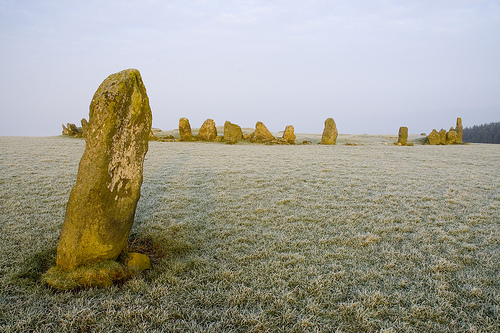On the levelled
summit of Tops Hill, about two miles south of the village of Raphoe, is this
fine stone circle, one of the few in NW Ireland. The name Beltany suggests
that the pagan festival of Beltane,
traditionally associated with the lighting
of hill-top fires to regenerate the sun, was celebrated on the site.
The ring is 44.2m (145ft) in diameter and
currently contains around 64 stones,
though originally there were an estimated eighty with average heights of
1.8m. The style is similar to the
circles in the Carrowmore cemetery; it is
possible that Beltany is a transitional ring between late passage-tombs and
early stone circles or a combination of both.
The circle,
which is substantially older than the Iron Age, surrounds a
tumulus. The tumulus may be the remains of a pillaged cairn, and some
theories claim that the whole site should be really classified as a round
cairn with the orthostats comprising a kerbing. (A Kerbed Passage mound)
The site was disturbed at the beginning of the century
resulting in many of
the stones to lean outward at
acute angles. When Oliver Davies visited the site in the late 1930s, he
reported that 'The platform had been recently and unscientifically
excavated, and had been left in dreadful confusion'.
At the ENE is a triangular slab whose inner
face is decorated with cup-marks.
Astronomy:
Apart from the obvious association through its name, there are also theories of astronomical alignments concerning the
circle. The most persuasive is from the high WSW pillar to the cup-marked
slab whose pointed top provides a sighting point towards the hill-summit of Tullyrap, a few miles away.

The Beltany Outlier.
This
single monolith 1.8m high
stands 20m to the SE. From the high pillarstone at the WSW of the circle
a cupmarked 1.5m high triangular slab at the ENE marks the point where
the sun rises on May Day (Bealtaine or 'Beltany'). There are also
standing-stones to the N and NW.
(Other
Prehistoric Irish Sites)